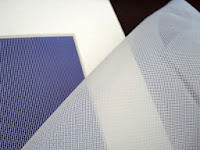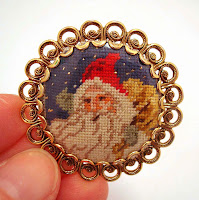Time to stitch on something different
 As you
stitch holiday projects for gifts or home decor this year, are you
getting bored with the same old fabrics? Another ornament on 18-count
mono canvas…or natural brown 28-count linen again… While these fabrics
are staples in any stitching studio, it's time to try something new, or
well, new to you. How about silk gauze?
As you
stitch holiday projects for gifts or home decor this year, are you
getting bored with the same old fabrics? Another ornament on 18-count
mono canvas…or natural brown 28-count linen again… While these fabrics
are staples in any stitching studio, it's time to try something new, or
well, new to you. How about silk gauze?
Silk
what? Kreinik sells silk gauze in all sizes, and it's a top secret
needlework fabric. Well, not really, but most people haven't heard of
it. In fact, however, this sheer, open-weave fabric made of pure silk
was pretty common in historical needlework. Our fore-stitchers had silk,
they knew how to weave, and they put the two together. It was sheer,
lightweight but sturdy, strong, and you could embroider on it. It was
good for clothes (a silk gauze robe was found in a tomb dating to 800
BC) and for samplers (Sampler and Antique Needlework Quarterly recently
featured a design that a 9-year-old stitched in silk thread on 55-count
silk gauze, in 1806). It's strength and lightweight qualities made it
useful for many embroidery applications over the centuries.
Today
silk gauze is primarily used by miniaturists to make doll-house sized
versions of needlepoint pillows, rugs, bellpulls, and samplers; 40-count
silk gauze is perfect for 1-inch to 1-foot scale. However, cross stitch
designers like Erica Michaels Designs have started using silk gauze as
alternate fabrics for stitching any kind of design. Finished silk gauze
stitchery fits into jewelry findings or miniature frames. It has become
the go-to fabric for "something different."
Solution:
Kreinik silk gauze comes in the following counts: 18, 20, 28, 30, 32,
35, 40, 47, 49, 60, 72, 84, and 90. So if you can't see to stitch on
40-count gauze, just try a 30-count, or a 20-count. (Tip: the larger the
number, the smaller the holes/canvas/fabric.)
Problem: "I'm a cross stitcher, and I've never stitched on silk gauze before."
Solution:
Start with a size that you are familiar with; if you normally cross
stitch on 28-count linen, start with 28-count silk gauze, for instance.
Don't attempt an heirloom right away. Try one of the free designs on the
Kreinik website, or any basic, small design. Almost any charted cross
stitch design can be used for silk gauze stitching. Pick a design
without quarter stitches, blended colors, backstitches, or elaborate
color changes to start. Stitch over one thread on silk gauze.
Problem: "Just working tent stitch or half-cross is boring."
Solution:
You can do any kind of stitch on silk gauze, it doesn't have to be tent
stitch. And you can use any kind of thread, as long as it fits through
the canvas holes or can be couched on top (so, basically, you can use
any threads). Patricia Parra is a master at combining needlepoint
stitches and specialty threads on fine counts of silk gauze. You don't
limit yourself when it comes to stitches and threads on regular
fabrics/canvases, so don't box yourself in on silk gauze. Experiment and
have fun.
Solution:
Well, that could be a problem depending on the design. If the whole
area is filled in with stitches, you can get away with a little bit (but
you don't want it to be too knotty to make it bumpy when you frame).
When stitching on silk gauze, a neat back is especially important if
some of the background is left unstitched, so here are some tips: when
starting a thread, try to use an ‘away waste knot’ to begin. You may
sometimes be able to end a thread using this same technique, resulting
in less bulk on the back of your work. When ending threads by ‘running’
under stitches.
Problem: "How do you finish a silk gauze stitched piece?"
Solution:
Depending on the size of your finished piece, you can put your silk
gauze stitchery in jewelry findings (raid Grandma's jewelry box, or
search antique stores), ornament frames that you find in craft stores,
or in miniature frames that you find in craft stores or independent
needlework stores. Kreinik also sells silk gauze already mounted in
decorative ornament frames, which saves time and money. If you stitched
your piece in a mat-board frame, either remove the tape holding the
gauze, or carefully cut out your piece leaving as much room around the
edges as possible. You can trim it later to fit into a frame. Side note:
Silk gauze is woven in a leno structure, which interlocks the weft
threads making it almost impossible for them to shift, so the edges
don't ravel like Aida cloth or linen.
Solution:
You probably won't find it in a Joann's or Hobby Lobby. So turn to an
indie needlework store. Don't have one near you? Go to www.kreinik.com
or choose your favorite online needlework shop. Kreinik sells silk
gauze wholesale to shops either in framed pieces (makes it easy to hold)
or by yardage.
So as
you have all of your holiday projects lined up, swap out the usual
fabrics for silk gauze. You will fall in love with the finished result!
Links of interest:
Stitching Tips: https://www.kreinik.com/shops/
Purchase, view catalog: http://www.kreinik.com/shops/
Kits (including Christmas projects): http://www.kreinik.com/shops/
How Patricia Parra does it: http://kreinikthread.blogspot.



